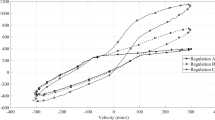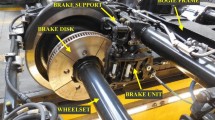Abstract
In this study, the effects of variable damping setting induced brake pressure oscillations on axle and wheel oscillations have been experimentally explored. For this, antilock brake system (ABS) tests are conducted on wet and slippery rough roads with hard, medium-hard and soft shock absorbers. In ABS tests, the axle height, the longitudinal and vertical axle accelerations have been measured. The results are discussed for time and frequency responses of axle vibrations in vertical and longitudinal direction. The time responses are separately considered for high and low piston velocities of damper. Also, in order to occur the effects of changes in ABS-brake pressure on axle vibrations, novel rules are designed. These rules are based on the integration of suspension dynamics into braking dynamics. The results show that the brake pressure is distinctly changed by variable damping settings. In time responses, these differences are determined by changes in time period and magnitude of brake pressure during build-up and reduction process. In frequency responses, the brake pressure differences are occurred by the different change frequencies of brake pressure causing resonance at axle vibrations. Also, the changes in magnitude of resonance peaks have determined the effects of brake pressure changes on axle vibrations. As a result, it is possible to damp the oscillations by changing the magnitude and frequency of brake pressure by means of the damper settings during ABS-braking.















Similar content being viewed by others
References
Van der Jagt P, Pacejka HB, Savkoor AR (1989) Influence of tyre and suspension dynamics on the braking performance of an anti-lock system on uneven roads. In: Proc of 2nd international EAEC conference on new developments in powertrain and chassis engineering. IMechE C382/047, Strasbourg, France
Mauer G, Gissinger G, Chamaillard Y (1994) Fuzzy logic continuous and quantizing control of an ABS braking system. SAE Technical Paper, 1994-01-0830
Yi J, Alvarez L, Claeys X, Horowitz R (2003) Emergency braking control with an observer-based dynamic tire/road friction model and wheel angular velocity measurement. Veh Syst Dyn 39(2):81–97
Bogdevicius M, Vladimirov O (2006) Efficiency of a braking process evaluating the roughness of road surface. Transport 21(1):3–7
Jian Z, Neng-Yen D, Gui-Zhen G (2006) Research on ABS wheel speed processing approaches based on 80C196 singlechip. In: Proc of IEEE international conference on vehicular electronics and safety, Beijing, China
Sharp RS, Allison DJ (2000) On the measurement of variations in the spin velocity of a wheel. Proc Inst Mech Eng, Part I J Syst Control Eng 214:149–156
Schneider MJ (1997) Use of a hazard and operability study for evaluation of ABS control logic. SAE Technical Paper 1997-01-0815
Schwarz R, Willimowski M, Isermann R, Willimowski P (1997) Improved wheel speed and slip determination considering influences of wheel-suspension dynamics and tire dynamics. SAE Technical Paper 1997-01-1117
Zegelaar PWA (1998) The dynamic response of tires to brake torque variations and road unevennesses. PhD Dissertation, Technical University of Delft
Kapitaniak T (1985) The influence of vehicle suspension displacements on the working of anti-lock braking systems. Proc Inst Mech Eng, Part C J Mech Eng Sci 178(85):35–43
Suraci E, Abagnale P, Amoroso D, Marinello F (2006) Development and road tests of an ABS control systems. Veh Syst Dyn 44:393–401
EUSAMA (1976) Recommendation for performance test specification of car vehicle suspension testing system. EUSAMA TS-02-76
Dixon JC (2007) The shock absorber handbook, 2nd edn. Wiley, England. ISBN 978-0-470-51020-9
SAE (Society of Automobile Engineering). Vehicle dynamics terminology. SAE J670e
Weispfennıng T (1997) Fault detection and diagnosis of components of the vehicle vertical dynamics. Meccanica 32:459–472
Acknowledgements
This study was supported by the Grants from The Scientific and Technological Research Council of Turkey (Project No. 107M188) and Scientific Research Foundation of Kocaeli University (Project No. 2007/31). Also, these projects were supported by Frenteknik and Hurmoglu Egitim Danışmanlık (HED) Academy companies. The authors are pleased to thank the individuals and companies who contributed to this study.
Author information
Authors and Affiliations
Corresponding author
Rights and permissions
About this article
Cite this article
Koylu, H., Cinar, A. Dynamical investigation of effects of variable damper settings induced brake pressure oscillations on axle and wheel oscillations during ABS-braking based on experimental study. Meccanica 48, 1093–1115 (2013). https://doi.org/10.1007/s11012-012-9654-y
Received:
Accepted:
Published:
Issue Date:
DOI: https://doi.org/10.1007/s11012-012-9654-y




